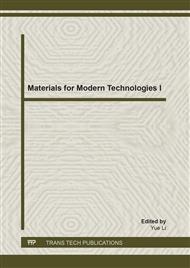[1]
V.E. Borisenko (Ed. ), Semiconducting Silicides, Springer, Berlin, 2000, pp.85-87.
Google Scholar
[2]
N. G. Galkin, T. A. Velichko and S. V. Skripka, A.B. Khrustalev , Semiconducting and structural properties of CrSi2 A-type epitaxial films on Si(111), Thin Solid Films. 280 (1996) 211-220.
DOI: 10.1016/0040-6090(95)08241-7
Google Scholar
[3]
L. F. Mattheiss, Structural effects on the calculated semiconductor gap of CrSi2, Phy. Rev. B. 43 (991) 1863-1866.
Google Scholar
[4]
L. F. Mattheiss, Electronic structure of CrSi2 and related refractory disilicides, Phys. Rev.B. 43 (1991) 549-555.
Google Scholar
[5]
M. P. C. M. Krijn and R. Eppenga, First-principles electronic structure and optical properties of CrSi2, Phys. Rev. B. 44 ( 1991) 9042-9044.
Google Scholar
[6]
V. Bellani, G. Guizzetti and F. Marabelli, Theory and experiment on the optical properties of CrSi2, Phys. Rev. B. 46 (1992) 9380-9389.
Google Scholar
[7]
J. M. Shannon, J. D. Hoyland and E. G. Gerstner, Growth of CrSi2 by radiation enhanced diffusion at room temperature, J. Appl. Phys. 92 (2002) 5068-5071.
DOI: 10.1063/1.1512968
Google Scholar
[8]
O. Filonenko, M. Falke and H. Hortenbach, Structure of thin CrSi2 films on Si(0 0 1), Applied Surface Science. 227 (2004) 341-348.
DOI: 10.1016/j.apsusc.2003.12.011
Google Scholar
[9]
T. Shishido, S. Okada and Y. Ishizawa, Molten metal flux growth and properties of CrSi2, Journal of Alloys and Compounds, 383 (2004) 319-321.
DOI: 10.1016/j.jallcom.2004.04.037
Google Scholar
[10]
D. Decker, E. Loos and C. Drobniewski, Structure and properties of CrSi2/Si multilayers, Microelectronic Engineering, 76 (2004) 331-335.
DOI: 10.1016/j.mee.2004.07.035
Google Scholar
[11]
H. Hohl, A. P. Pamirez and T. T. M. Palstraet, Thermoelectric and magnetic properties of Cr1 −xVxSi2 solid solutions, Journal of Alloys and Compounds, 248 (1997) 70-76.
DOI: 10.1016/s0925-8388(96)02646-1
Google Scholar
[12]
Z. J. Pan, L .T. Zhang and J. S. Wu, Effects of Al doping on the transport performances of CrSi2 single crystals, Scripta Materialia, 56 (2007) 245-248.
DOI: 10.1016/j.scriptamat.2006.09.015
Google Scholar
[13]
Z. J. Pan, L. T. Zhang and J.S. Wu, Effects of V doping on the transport performances of CrSi2 single crystals, Scripta Materialia, 56 (2007) 257-260.
DOI: 10.1016/j.scriptamat.2006.10.027
Google Scholar
[14]
X. Ye, J. Kuang, X. Li, G. Tang, Microstructure, properties and temperature evolution of electro-pulsing treated functionally graded Ti–6Al–4V alloy strip, Journal Of Alloys And Compounds. 599 (2014) 1-9.
DOI: 10.1016/j.jallcom.2014.02.055
Google Scholar
[15]
X. Ye, G. Tang, G. Song, J. Kuang, Effect of electropulsing treatment on the microstructure, texture, and mechanical properties of cold-rolled Ti–6Al–4V alloy, Journal Of Materials Research. 29 (2014) 1500-12.
DOI: 10.1557/jmr.2014.171
Google Scholar
[16]
X. Ye, X. Li, G. Song, G. Tang, Effect of recovering damage and improving microstructure in the titanium alloy strip under high-energy electropulses, Journal Of Alloys And Compounds. 616 (2014) 173-83.
DOI: 10.1016/j.jallcom.2014.07.143
Google Scholar
[17]
X. Ye, Y. Ye, G. Tang, Effect of electropulsing treatment and ultrasonic striking treatment on the mechanical properties and microstructure of biomedical ti-6Al-4V alloy, Journal of the Mechanical Behavior of Biomedical Materials. 40 (2014).
DOI: 10.1016/j.jmbbm.2014.08.022
Google Scholar
[18]
S. Y. Zhou, Q. Xie, W. J. Yan and Q. Chen, First-principle study on the electronic structure of stressed CrSi2, Science in China Series G: Phys Mech Astron, 52(1) ( 2009) 76-81.
DOI: 10.1007/s11433-009-0016-2
Google Scholar
[19]
C. G. Broyden, The Convergence of a Class of Double-rank Minimization Algorithms: 2. The New Algorithm, Journal of the Institute for Mathematics and Applications, 6 ( 1970) 222-231.
DOI: 10.1093/imamat/6.3.222
Google Scholar
[20]
R. Fletcher, A new approach to variable metric algorithms, Computer Journal, 13(3) (1970) 317-322.
Google Scholar
[21]
D. Goldfarb, A family of variable-metric methods derived by variational means, Mathematics of Computation, 24(109) (1970) 23-26.
DOI: 10.1090/s0025-5718-1970-0258249-6
Google Scholar
[22]
D.F. Shanno, Conditioning of quasi-Newton methods for function minimization,Mathematics of Computation, 24(111) (1970) 647-656.
DOI: 10.1090/s0025-5718-1970-0274029-x
Google Scholar
[23]
J.P. Perdew, K. Burke and M. Ernzerhof, Generalized Gradient Approximation Made Simple, Phys. Rev. Lett. 77 (1996) 3865-3868.
DOI: 10.1103/physrevlett.77.3865
Google Scholar
[24]
H.J. Monkhorst and J.D. Pack, Special points for Brillouin-zone integrations, Phys. Rev. B. 13 (1976) 5188-5192.
DOI: 10.1103/physrevb.13.5188
Google Scholar
[25]
Q.C. Gu, S. C Lou and Q. P Dai, Table of Chemical. Science press of Jiangsu, (1979).
Google Scholar


